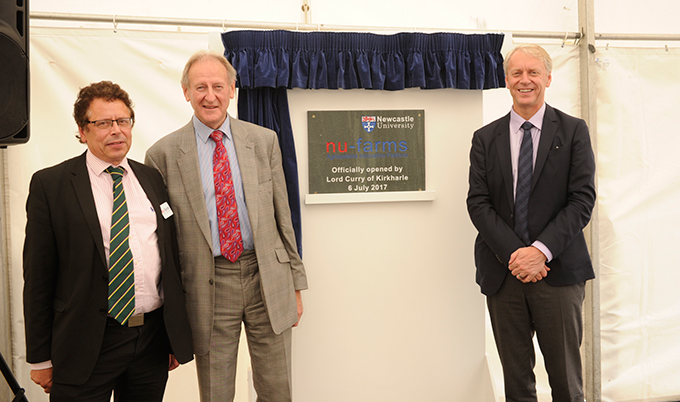NU-farms launch
A new era of agricultural research at Newcastle
Published on: 7 July 2017
Two national centres of excellence have opened at Newcastle University’s Cockle Park farm, heralding a new era of agricultural research at Newcastle.
Linking crop and animal science
The Centre for Digital Innovation Applied to Livestock (C-DIAL) is a purpose-built research facility that uses the latest sensor-based and automated technologies for the continuous monitoring of the performance, health and welfare of livestock. It brings together the expertise of animal and computer scientists, veterinarians, engineers and mathematicians at Newcastle University, working with the farming community.
Also launching is the Centre for Crop Health and Protection (CHAP) an innovative field laboratory unit for the evaluation and testing of ecologically-friendly pesticides and biocontrol agents. It has been set up to help meet the challenges of feeding a rapidly growing population through sustainable agriculture.
Both of the new facilities were unveiled at a special event at Cockle Park to showcase the range of unique and cutting edge resources provided by both of the University’s farms – Cockle Park and Nafferton – that link crop and animal science with lab and field applications.

Sustainable and secure agriculture
Professor Rob Edwards, who has been appointed Head of the new School of Natural and Environmental Sciences at Newcastle University, said: “The launch of these exciting research facilities will give farmers and other professionals involved in agricultural and related businesses the knowledge, skills and technology to improve crop performance and meet the highest possible standards of livestock welfare and management.
“At a time when we’re marking 125 years of agriculture at Newcastle, these two centres of excellence will help us continue to lead the way in ground-breaking agricultural research, helping the next generation of farmers to ensure we have a sustainable and safe source of food for another 125 years. “
The C-DIAL facility includes four climate controlled areas where animals can be housed. One of these is set up with state-of-the-art electronic feeders for pigs, allowing the individual feed intake of pigs to be monitored – the first facility in the UK to operate this system on this scale.
It also has an 18m gait laboratory that provides farmers, vets, and animal scientists the facility to accurately measure and analyse small changes in an animal’s gait, potentially diagnosing the first signs of lameness.
C-DIAL has been designed as part of the Centre for Innovation Excellence in Livestock, a gateway to a consortium of 11 world-class research institutes collaborating to develop new industry-needed solutions.
Case study
One example of the type of project that C-DIAL could be used for is to develop a better understanding of pig movements. For example, using sensors and automated technologies, researchers at Newcastle University have developed a new way to predict the movement and lying style of sows, allowing breeders and farmers to accurately identify when there is a crushing risk to piglets.
Around the time of giving birth, or farrowing, sows generally show nesting behaviour and an increase in activity. After birth, many piglets are at risk of being crushed by their mother as she rolls from one side to another or moves from a standing position to sitting or lying down.
Although the standard practice is to place farrowing sows in crates to reduce the risk of crushing, individual pigs still need to be monitored. Despite this, crushing remains the main cause of death in piglets with up to 10% each year dying this way.
To address this, agriculture experts and computer scientists at Newcastle devised the first automated way to detect the transitions between positions, without the need for observation by humans.
Using sensors placed – uniquely – between the sow’s tail-head and hips, the study team successfully identified behaviours such as how many times she changed position, how quickly the transitions between positions were made and how long she spent in each position, and relate these to the risk to the crushing of her piglets.
This information was then used to build a lying behaviour profile for each sow in order to predict when a change in position would occur.
Ilias Kyriazakis, Professor of Animal Health and Nutrition, Newcastle University, explained: “Being able to predict a sow’s lying style means we can identify when issues are most likely to occur. This allows breeders to select sows on the basis of these traits, and it provides farmers and stock managers with a better understanding of the right time to intervene in order to manage the risk to piglets.
“Crushing by farrowing sows is a significant welfare issue so this new technique holds promise for improving the health and welfare of pigs, while also reducing costs.”
The team that conducted the research, published in Computers and Electronics in Agriculture, say that the new technique could be applied to any size of herd, but the characterisation of individual sows is of value to pig breeders.
Reference: 'Porcine lie detectors: Automatic quantification of posture state and transitions in sows using inertial sensors' - Robin Thompson, Stephanie M. Matheson, Thomas Plötz, Sandra A.Edwards, Ilias Kyriazakis https://doi.org/10.1016/j.compag.2016.07.017



